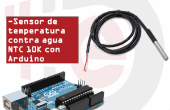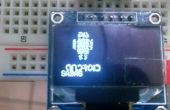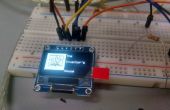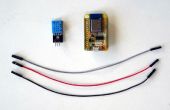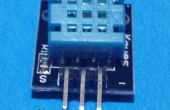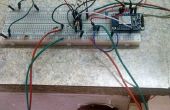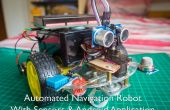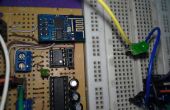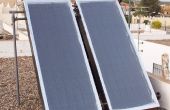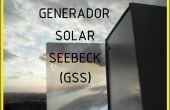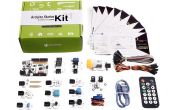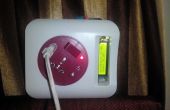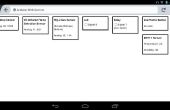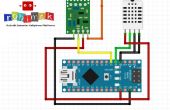Stap 2: Codigo


Lo primero que debemos la realizar es agregar tarjeta de desarrollo ESP8266 een nuestro IDE de Arduino si aun geen lo han realizado pueden seguir el siguiente instructable desde el paso 2:
Ahora debemos de agregar la librería de DHT de Adafruit es una librería controlar el sensor DHT11 y DHT22, ademas funciona correctamente con el ESP8266
https://github.com/adafruit/DHT-sensor-Library
Una vez reiniciado nuestro IDE ingresamos el siguiente código y cambiamos los datos de la wifi a la que lo vamos een contact
Código nl gist: https://gist.github.com/sabas1080/68c0f5cf6d4bb363bc39
<p>/* DHTServer - ESP8266 Webserver with a DHT sensor as an input<br> Based on ESP8266Webserver, DHTexample, and BlinkWithoutDelay (thank you) Version 1.0 5/3/2014 Version 1.0 Mike Barela for Adafruit Industries */ #include #include #include #include #define DHTTYPE DHT11 #define DHTPIN 13 const char* ssid = "Name Wifi"; const char* password = "Password wifi"; ESP8266WebServer server(80); // Initialize DHT sensor // NOTE: For working with a faster than ATmega328p 16 MHz Arduino chip, like an ESP8266, // you need to increase the threshold for cycle counts considered a 1 or 0. // You can do this by passing a 3rd parameter for this threshold. It's a bit // of fiddling to find the right value, but in general the faster the CPU the // higher the value. The default for a 16mhz AVR is a value of 6. For an // Arduino Due that runs at 84mhz a value of 30 works. // This is for the ESP8266 processor on ESP-01 DHT dht(DHTPIN, DHTTYPE, 11); // 11 works fine for ESP8266 float humidity, temp_f; // Values read from sensor String webString=""; // String to display // Generally, you should use "unsigned long" for variables that hold time unsigned long previousMillis = 0; // will store last temp was read const long interval = 2000; // interval at which to read sensor void handle_root() { server.send(200, "text/plain", "Hello from the weather esp8266, read from /temp or /humidity"); delay(100); } void setup(void) { // You can open the Arduino IDE Serial Monitor window to see what the code is doing Serial.begin(115200); // Serial connection from ESP-01 via 3.3v console cable dht.begin(); // initialize temperature sensor // Connect to WiFi network WiFi.begin(ssid, password); Serial.print("\n\r \n\rWorking to connect"); // Wait for connection while (WiFi.status() != WL_CONNECTED) { delay(500); Serial.print("."); } Serial.println(""); Serial.println("DHT Weather Reading Server"); Serial.print("Connected to "); Serial.println(ssid); Serial.print("IP address: "); Serial.println(WiFi.localIP()); server.on("/", handle_root); server.on("/temp", [](){ // if you add this subdirectory to your webserver call, you get text below :) gettemperature(); // read sensor webString="Temperature: "+String((int)temp_f)+" C"; // Arduino has a hard time with float to string server.send(200, "text/plain", webString); // send to someones browser when asked }); server.on("/humidity", [](){ // if you add this subdirectory to your webserver call, you get text below :) gettemperature(); // read sensor webString="Humidity: "+String((int)humidity)+"%"; server.send(200, "text/plain", webString); // send to someones browser when asked }); server.begin(); Serial.println("HTTP server started"); } void loop(void) { server.handleClient(); } void gettemperature() { // Wait at least 2 seconds seconds between measurements. // if the difference between the current time and last time you read // the sensor is bigger than the interval you set, read the sensor // Works better than delay for things happening elsewhere also unsigned long currentMillis = millis(); if(currentMillis - previousMillis >= interval) { // save the last time you read the sensor previousMillis = currentMillis; // Reading temperature for humidity takes about 250 milliseconds! // Sensor readings may also be up to 2 seconds 'old' (it's a very slow sensor) humidity = dht.readHumidity(); // Read humidity (percent) temp_f = dht.readTemperature(); // Read temperature as Celsius // Check if any reads failed and exit early (to try again). if (isnan(humidity) || isnan(temp_f)) { Serial.println("Failed to read from DHT sensor!"); return; } } }</p> Ponemos el modo Boot el ESP8266 y cargamos el sketch
